Master Venting
Air-binding is the primary cause of uneven heat in steam systems. Curing it requires master vents.
Virtually every steam system needs master vents, with just two exceptions. Single-family homes are so small that radiator vents suffice for air elimination. The second exception is systems operated with the steam supplies in vacuum, but these are rare in practice.
First Correct Wet Steam and Backpitches
If the boiler is making wet steam, or if the steam mains have backpitched runs, water can leak from master vents and cause property damage. Such conditions must be corrected before master vents are installed.
Main Line Venting
Determine Main Line Vent Location
Main line venting must be generous, but doesn’t have to be precise. The goal is to put clusters of fast vents near the ends of the largest mains. In a six-family building with a single steam-main running down the middle of the basement, the only main-line vent needed will be at the end of that single steam main. Larger buildings typically need the mains to be vented at three to five locations.
Walk the basement to find the spots that need venting. Make a simple diagram of the steam mains (see sketch below). This is easier if you go to the roof first and sketch the building outline (also note where the vent stacks and bulkheads are). Even better is if management can provide you with a typical floorplan. They usually can’t, but it’s worth asking.
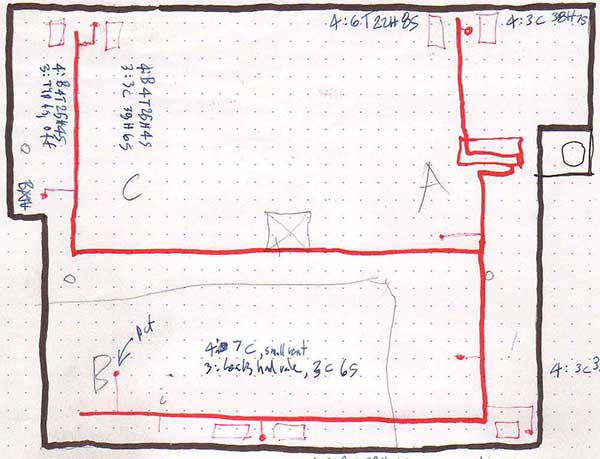
Pay special attention to building areas that get poor heat, and be sure to vent there.
Don’t worry about smaller branch lines.
It’s best not to install vents at the ends of long dry returns. Instead, put the vents near the last takeoff from the supply main.
Do NOT install vents into electric rooms. Make the connection in an adjacent room, or run the connection out through the wall.
Piping Details for Main Line Vents
Main line vents should be carefully detailed to ensure smooth installation.
Connection Types
Vent connections can be made by cutting in fittings, by welding on weld-o-lets, or by drilling and tapping. Of the three methods, drilling and tapping is often the most cost-effective. It is under-utilized by most plumbers. Experience has shown that there is little danger of tappings leaking at routine steam pressures.
Best Spots to Connect Main Line Vents
Vents do not need to be installed directly onto the steam main. They can be installed onto branch pipes that connect near the end of the main. They can be installed onto drip piping that’s 1¼” and larger, as here:
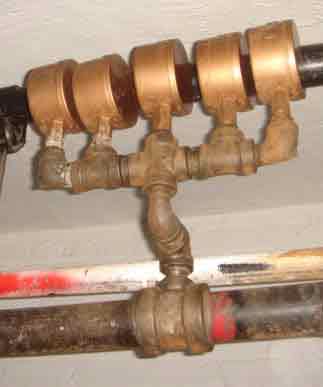
Vents can even be installed onto the sides of drip legs.

But do NOT install vents on top of a drip leg, or they will be destroyed.
General Principles for Piping Main Line Vents
When detailing vent connections, the goal is to prevent spitting. Water must be kept away from the vent, and the vents must drain.
Keeping the piping full size right up to the vents helps. So does installing the vents as high as possible.
Avoid adding horizontal piping. Come off the top of the steam pipe if possible, otherwise come off at 45° above horizontal.
Water can splash back from elbows, so wherever possible install vent connections at least 18” away from the nearest elbow.
When ganging vents, the common piping should be minimum ¾”.
If installing onto a drip leg, make the connection near the top of the leg, on a side, using a close nipple, then pipe up as high as possible.
Main Line Vent Sizing
The bigger the mains, the more vents they need. The chart below shows how many vents should be installed, based on the total volume of the steam mains being vented. (Note: different models of vents may be used, after adjusting for the different venting rates.)
Large mains typically divide up into a few smaller ones. The vents go at the ends of the smaller mains, but there need to be enough of them to vent all the air in the large common piping as well. The calculations do not need to be precise, just generous. Master vents cannot be too large.
| Pipe Size | #2 Vents Per 100' |
|---|---|
| 2" | 1 |
| 4" | 3 |
| 5" | 4 |
| 6" | 6 |
| 8" | 10 |
Riser Venting
Virtually any building three stories and up should get riser vents. They can be skipped in buildings without vertical imbalance, but those are rare.
In downfeed systems the riser vents go in the basement, but again those systems are rare.
Riser venting is harder than main line venting. Not only does the work have to be done in occupied spaces, but there are many more risers than steam mains.
If the risers are exposed, the best job is to drill and tap the riser. Do this near the ceiling, on the floor just below the top floor (unless the risers go all the way up through the top floor, which is rare).
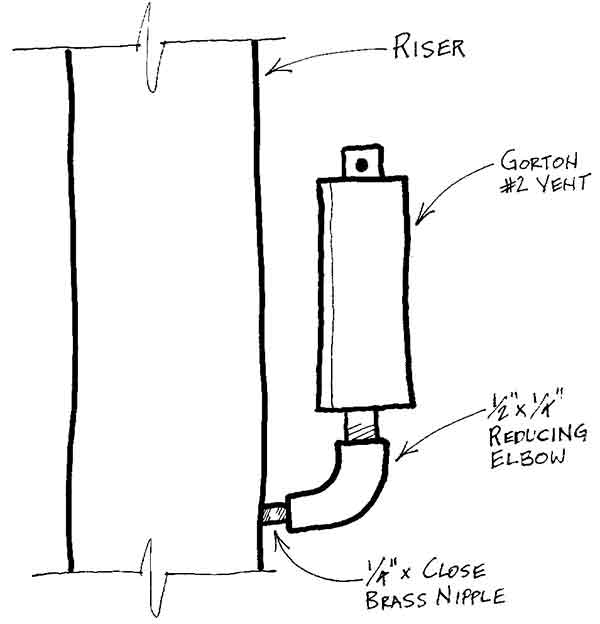
The work is much trickier when the risers are buried inside walls. If the top floor heaters are enclosed, it is sometimes practical to drill and tap the stub-out just below the hand-valve:
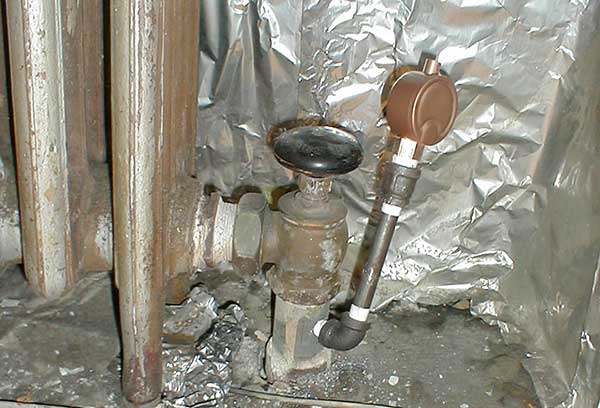
If the hand-valves are being replaced (hopefully with TRVs) then a riser vent can be added to the work, like this:
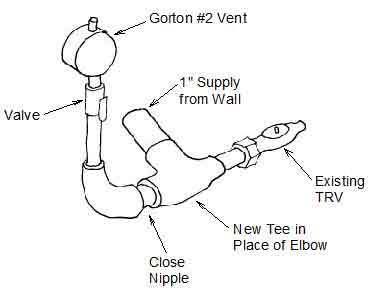
In one-pipe systems, the only real option may be to put fast vents onto the top floor radiators. In well-maintained two-pipe systems, the risers can vent through the top-floor radiator traps.
Vents comparable to Gorton #D or #1 are sufficient for systems up to six floors. In taller buildings vents comparable to a Gorton #2 should be used. These can be piped with a ¼” IPS tapping, a brass close nipple, and ½” x ¼” elbow.
Radiator Vents
Radiator vents should be slow models, such as Hoffmans. This will help balance the system and prevent overheating. With slow vents on the radiators, the steam will first flow towards the fast vents at the ends of the mains and risers, and only then start filling the radiators. The goal is for all the radiators in the building to start filling with steam at about the same time, no matter how far away from the boiler they are. This makes for much more even heat. In this way, small radiator vents combine with large master vents to balance the steam distribution.